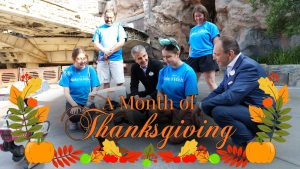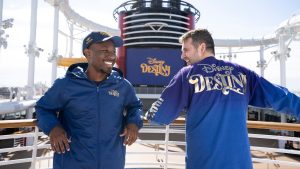Today is Jim Henson’s birthday. He would have been 77 years old today. For me, he has always been an inspiring figure. There has always been something amazing to me about all the different personalities and characters that Jim Henson brought together to create something wonderful. What was amazing about Jim Henson is that what he did behind the scenes was often what was happening on TV or the big screen as well. Both on and off the screen all those differences came together for a common goal bound by friendship.
Jim Henson Beginnings
“At the University of Maryland, my first year I started off planning to major in art because I was interested in theatre design, stage design or television design.”
– Jim Henson
Jim Henson was born James Maury “Jim” Henson on September 24, 1936 to Betty Marcella (née Brown) and Paul Ransom Henson in Greenville, Mississippi. He started life in Mississippi before moving with his family to Hyattsville, Maryland, near Washington D.C. Even at a young age puppetry was a part of his life. He would listen to Edgar Bergen on the radio and then when television came along he saw puppeteers Burr Tillstrom along with Bil and Cora Baird. High School found Jim Henson working for WTOP-TV where he created a puppet television show called The Junior Morning Show. This show aired on Saturday mornings.
Jim Henson went to college at the University of Maryland, College Park. He intended to get a degree in Studio Arts but after taking a puppetry class, his focus changed. He started learning more about materials that could be used for puppetry in home economics class. In fact, he ended up graduating with a degree in home economics. During college he also began work on a show called Sam and Friends for WRC-TV. This five minute program was a first draft to the characters and ideas that would culminate in the creation of the The Muppet Show. It also introduced the world to perhaps the most famous frog, Kermit.
His work with WRC-TV changed how puppetry was done forever. No longer was a stage needed for the puppets but instead, the camera became the stage. Jim Henson also began to change how puppets were made. He created more flexible puppets that would be able to show a wider range of emotion and presence, as opposed to wooden heads. Rods were added so that arms/hands could be more expressive rather than using marionettes that had arms controlled by strings. Finally, he decided to make their mouths more precise in the way they spoke so the mouth matched the words being spoken. While working on all of this, he enlisted the help of a sophomore named Jane Nebel to help with Sam and Friends. She later became Henson’s wife. Following college Jim Henson spent months visiting Europe and re-evaluating his future with puppetry. As he wrestled with the questions of his future in the industry he experienced the puppetry that was found in Europe. In Europe puppetry was viewed as an art-form and not just child’s game.
Here Come The Muppets
“[Kids] don’t remember what you try to teach them. They remember what you are.”
― Jim Henson
The sixties found Jim Henson now married to Jane Nebel. Most of his puppetry efforts were spent making commercials during the early sixties. 1963 found the Hensons living in New York and as kids came along, Jane became a full time mother. Jim Henson then hired Jerry Juhl & Frank Oz to replace her at Muppets, Inc. Frank Oz and Jim Henson became close collaborators for the rest of Henson’s life. Muppets, Inc continued to work with advertisements and contribute to other television shows throughout the 1960’s. The first break for the Muppets came from The Jimmy Dean Show where a muppet named Rowlf began making regular appearances. The Muppets would also appear on The Today Show and The Ed Sullivan Show, helping to further their gains into the hearts of American television viewers. During this time, Henson also began exploring film-making and made a 9 minute shore called Time Piece. It was nominated for an Academy Award for Live Action Short in 1966. Henson also began developing other projects during this time.
1969 found Jim Henson being asked to help develop a new television show that would be aimed at kids via public television. Initially the Muppets and the folks who lived on Sesame Street appeared separately (much like on Mr. Roger’s Neighborhood). However, this format received poor reviews and soon the role of the Muppets expanded and everyone worked together. The success of Sesame Street offered Jim Henson and the Muppets the freedom to not have to do commercials anymore and begin creating their own content. Sesame Street also helped Jim Henson give birth to some classic Muppet characters that have lived on and been loved through the years. While working on Sesame Street, Jim Henson also began Tales from Muppetland. This series was hosted by Kermit the Frog and re-told classic fairytales in a way only the Muppets could.
It’s the Muppet Show!
“As children, we all live in a world of imagination, of fantasy, and for some of us that world of make-believe continues into adulthood.”
― Jim Henson
The seventies found the continued rising success of Sesame Street and a rising concern by Jim Henson that the Muppets would be viewed only as a provider of children’s entertainment. In an effort to branch out, Henson collaborated with the newly created Saturday Night Live for some comedic sketches. The Muppets appeared on Saturday Night Live four times between October 1975 and January 1976.
Around that time Jim Henson began work on another idea he had for a weekly show. As with so many other new ideas, there were people who didn’t believe it would succeed. Jim Henson pitched The Muppet Show to networks around the United States and was rejected repeatedly. Finally, he went to the United Kingdom where the idea was picked up by Lew Grade who agreed to finance the show. The Muppet Show was produced in the UK and then syndicated around the globe. It reached over 100 countries around the globe with 235 million viewers. Jim Henson was an active leader of the Muppets and performed many of the characters found on the show. These included: Kermit the Frog, Rowlf, the Swedish Chef, Waldorf the heckler and Dr Teeth of the Electric Mayhem. Frank Oz performed many of the other lead characters including Fozzie Bear and Miss Piggy. The Muppet Show was based around the idea of the Muppets running a theater with a weekly show, hosted by Kermit the Frog.
The Muppets would soon outgrow television and soon found themselves on the big screen in The Muppet Movie, a creative semi-autobiographical story about the rise of the Muppets. The success of this movie led to a sequel soon after and subsequent movies that continue today.
The Force Is Strong With This One
“Life’s like a movie, write your own ending. Keep believing, keep pretending. We’ve done just what we set out to do. Thanks to the lovers, the dreamers and you.”
― Jim Henson
The success of The Muppet Show and of a certain Star Wars episode of the show led to George Lucas reaching out to Jim Henson for help with a character for the second Star Wars movie, The Empire Strikes Back. Jim Henson helped create Yoda and then suggested to Lucas that Frank Oz would be the perfect person to bring this Jedi master to life. Oz performed as the puppeteer and voice for Yoda in Star Wars: The Empire Strikes Back and the four movies that followed with Yoda appearing in them. The collaboration between Jim Henson and George Lucas continued beyond Star Wars and eventually led to the development of Labyrinth.
Continuing On
“I don’t know exactly where ideas come from, but when I’m working well ideas just appear. I’ve heard other people say similar things – so it’s one of the ways I know there’s help and guidance out there. It’s just a matter of our figuring out how to receive the ideas or information that are waiting to be heard.”
– Jim Henson
Jim Henson was a creator and he continued to create other projects and shows throughout his short life. 1983 brought about the creation of Muppet Babies. The 80’s also brought about Fraggle Rock with a new family of Muppet favorites that has delighted generations for three decades. He also worked on The Storyteller and The Jim Henson Hour.
Looking Ahead & Partnering with Disney
“I believe in taking a positive attitude toward the world, toward people, toward my work. I think I’m here for a purpose. I think it’s very likely that we all are, but I’m only sure about myself. I try to tune myself in to whatever it is that I’m supposed to be, and I try to think of myself as a part of all of us – all mankind and all life. I find it’s not easy to keep these lofty thoughts in mind as the day goes by, but it certainly helps me a great deal to start out this way.”
– Jim Henson
Call it vision, foresight, or premonition but as the 80’s wound down and the 90’s were looming ahead Jim Henson began thinking about the legacy of the Muppets. Jim Henson began to look around for a caretaker for his Muppets for the inevitable day when he would no longer be the active master puppeteer of the Muppets. Henson began working towards a partnership with the Walt Disney Company. He hoped that this would ensure the legacy of the Muppets and also allow Disney to cover the business workings of the Muppets and allow him to focus on the creative aspects.
Together Henson and the Muppets created a television sitcom called Dinosaurs. He also helped create The Muppets at Walt Disney World and a new attraction for Disney Theme Parks called Muppet Vision 3D. This attraction would eventually be at both Hollywood Studios in Walt Disney World and Disney California Adventure at the Disneyland Resort. Sadly, the deal Henson was working towards would not be finalized until after his death.
The End
“My hope still is to leave the world a bit better than when I got here.”
Jim Henson
1990 came along and Jim Henson started dealing with flu-like symptoms. Before taping on The Arsenio Hall Show, Henson mentioned to his publicist that he had a sore throat and was feeling tired but thought it would go away. This was May 4, 1990. A little over a week later, Henson went to a doctor while visiting his father and step-mother in North Carolina. The doctor found no evidence of pneumonia and Henson was given aspirin. Jim Henson continued to feel under the weather and returned to New York and then cancelled a Muppet recording session on May 14th. May 15th found him continuing to feel ill. Jane, now separated from Henson, visited him. He told her that he thought he might be dying after he began to struggle with breathing and coughed up blood. However, he refused to go to the hospital until almost five the following morning. Despite every effort, on May 16, 1990, Henson died at New York Hospital of organ failure resulting from Streptococcus pyogenes.
The world mourned his death. Yet, his memorial services were a celebration of his life. The services included Big Bird singing It’s Not Easy Being Green, some of his favorite songs being sung by his Muppeteers and even the Muppets themselves singing Just One Person. This song was performed once again for The Muppets Celebrate Jim Henson, a beautiful tribute that was aired later in 1990.
Jim Henson: The Biography was released today. This book, by Brian Jay Jones, takes a look at both Hensons life and also his career.
Jim Henson Lives On
“When I was young, my ambition was to be one of the people who made a difference in this world. My hope is to leave the world a little better for having been there.”
Jim Henson
1990 might have ended Jim Henson’s direct collaboration with the Muppets but it was not the end of his influence. Over two decades later the Muppets continue to live on with appearances on TV shows, internet clips, and feature length movies. The Jim Henson Foundation continues to “to promote and develop the art of puppet theater in the United States.” Jim Henson’s Creature Shop “provides digital visual effects, animatronic creatures, animation and soft puppets to the international film, television, online and advertising industries.” It has built characters for Sesame Street, Dinosaur, Farscape, George of the Jungle, 101 Dalmations, The Hitchhikers Guide to the Galaxy, Where the Wild Things Are, and Sid the Science Kid on PBS. His legacy also lives on in museums, stars on the Hollywood Walk of Fame, statues, and other dedications to his memory in countless venues.
Jim Henson was the master puppeteer. He brought puppetry into the main stream with a group of crazy misfits that overcame their differences and obstacles through friendship. Jim Henson inspired countless young puppeteers to pursue their dreams, despite what people might say. He also has helped hundreds of millions of children around the world learn their ABCs and 123s throughout the many years that Sesame Street has been on television.
Jim Henson once said, “I’ve always tried to present a positive view of the world in my work. It’s so much easier to be negative and cynical and predict doom for the world than it is to try and figure out how to make things better. We have an obligation to do the latter.” This is perhaps his greatest contribution to the world. He brought to a dark and cynical world a ray of positivity that was comedic yet poignant.
So happy birthday Jim Henson. There is no gift we can give you that measures up to the gift you gave us. So instead, we remember you and what you brought to the world. We celebrate who you were and the creations you brought from the world of your imagination to our reality.





